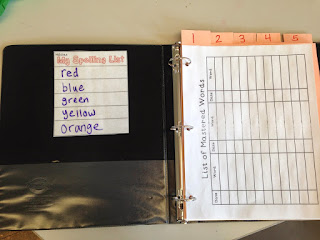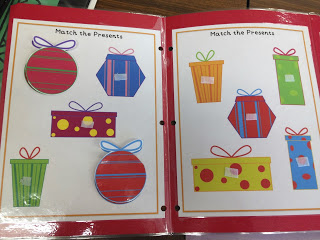1. Independent work binder at our independent work station. Each binder has enough laminated worksheets to last 1 week...then the binders are cleaned off (students use dry erase markers to complete work) and are rotated to a different student at a similar level.
2. Weekly Work. Similar to the above binder, this reading binder has 5 days worth of reading/spelling/writing work. I numbered the tabs instead of writing days of the week, as not all of these students are reading yet.
3. Daily Work. Students are expected to complete all of the work in the binder each day. Some pages work on reviewing skills previously taught. A variety of pages of previously mastered skills can be rotated in/out of the binder to make sure our students are maintaining skills. Some other pages are skills that are currently being taught. As student master skills, prompts on pages may be faded out to increase independence or new pages with new skills may be introduced.
This is a binder at our reading station (each student has their own) and these are used for students who are not yet writing fluently.
At the beginning of the year (or after I get to know each student's skills), for my non-writers, I send home a homework binder that covers already mastered skills.
I also have a morning binder for each student that starts with their schedule on the first page and then moves onto some daily work related to calendar, weather, social skills, journals, and other IEP goal areas that need daily practice and may not be accounted for elsewhere in our schedule. These are tailored to student level of functioning. For a sampling of activities in a beginner level, intermediate level, and advanced level binder, click on any of these links.
4. Schedules. As I said above, each of my morning binders starts out with a schedule tailored to the students individual level. Some students have Velcro schedules where they remove the picture as they go throughout their day, while others have word schedules that they cross off as they go. For more on individualizing schedules, see this post and for a variety of schedule types, see this one.
5. Organization/Data. I love using binders (as well as clip boards) to keep my student data organized. My reading data for all students is stored in this lovely little binder.
While over at my fluency station, each student has their own data binder for my assistant to keep track of. These are stored in a FREE milk crate from our lunch room.
6. Storage. I keep all of my worksheets stored in binders for easy access/photo copying.
For my science units, I keep all the worksheets (organized by month) in 2 binders, and all of the hands-on materials stored by topic in clear plastic bins.
When I have student specific file folders I want completed, I sometimes hole punch the middle of the file folder and put it in a student's binder of work. Other times, at certain stations that do not have shelves, it is easier to store my file folders in a binder for quick access.
7. Communication Systems. If you can't afford the pricey PECS binders, using any old binder from the store is a great way to create a communication system for your student to store and easily access all of his picture symbols. I love this example from Mothers Raising Brothers
8. Adapted Books. A lot of times I bound my adapted books, but for books you are only using for a short time, a great option would be to throw pages into top-loading sheets and insert them into a binder!
I would love to hear how you use binders in your classroom. Feel free to leave comments or email me with pictures (autismtank@gmail.com) and I will add your ideas to this post as well!




















No comments:
Post a Comment